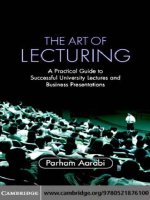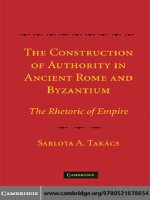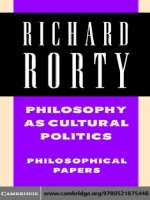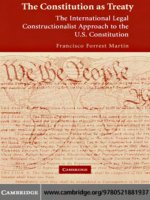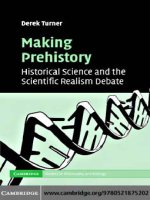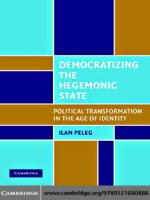cambridge university press making prehistory historical science and the scientific realism debate aug 2007 kho tài liệu bách khoa
Bạn đang xem bản rút gọn của tài liệu. Xem và tải ngay bản đầy đủ của tài liệu tại đây (1.16 MB, 239 trang )
This page intentionally left blank
Making Prehistory
Scientists often make surprising claims about things that no one can
observe. In physics, chemistry, and molecular biology, scientists can at least
experiment on those unobservable entities, but what about researchers in
fields such as paleobiology and geology who study prehistory, where no
such experimentation is possible? Do scientists discover facts about the
distant past or do they, in some sense, make prehistory? Derek Turner
argues that this problem has surprising and important consequences for
the scientific realism debate. His discussion covers some of the main positions in current philosophy of science – realism, social constructivism,
empiricism, and the natural ontological attitude – and shows how they
relate to issues in paleobiology and geology. His original and thoughtprovoking book will be of wide interest to philosophers and scientists
alike.
d e r e k t u r n e r is Assistant Professor of Philosophy at Connecticut
College.
cambridge studies in philosophy and biology
General Editor
Michael Ruse Florida State University
Advisory Board
Michael Donoghue Yale University
Jean Gayon University of Paris
Jonathan Hodge University of Leeds
Jane Maienschein Arizona State University
Jesus
´ Moster´ın Instituto de Filosof´ıa (Spanish Research Council)
Elliott Sober University of Wisconsin
Recent Titles
Alfred I. Tauber The Immune Self: Theory or Metaphor?
Elliott Sober From a Biological Point of View
Robert Brandon Concepts and Methods in Evolutionary Biology
Peter Godfrey-Smith Complexity and the Function of Mind in Nature
William A. Rottschaefer The Biology and Psychology of Moral Agency
Sahotra Sarkar Genetics and Reductionism
Jean Gayon Darwinism’s Struggle for Survival
Jane Maienschein and Michael Ruse (eds.) Biology and the
Foundation of Ethics
Jack Wilson Biological Individuality
Richard Creath and Jane Maienschein (eds.) Biology and
Epistemology
Alexander Rosenberg Darwinism in Philosophy, Social Science,
and Policy
Peter Beurton, Raphael Falk, and Hans-Jorg
¨ Rheinberger (eds.)
The Concept of the Gene in Development and Evolution
David Hull Science and Selection
James G. Lennox Aristotle’s Philosophy of Biology
Marc Ereshefsky The Poverty of the Linnaean Hierarchy
Kim Sterelny The Evolution of Agency and Other Essays
William S. Cooper The Evolution of Reason
Peter McLaughlin What Functions Explain
Steven Hecht Orzack and Elliott Sober (eds.) Adaptationism and
Optimality
Bryan G. Norton Searching for Sustainability
Sandra D. Mitchell Biological Complexity and Integrative Pluralism
Greg Cooper The Science of the Struggle for Existence
Joseph LaPorte Natural Kinds and Conceptual Change
Jason Scott Robert Embryology, Epigenesis, and Evolution
William F. Harms Information and Meaning in Evolutionary Processes
Marcel Weber Philosophy of Experimental Biology
Markku Oksanen and Juhani Pietorinen Philosophy and Biodiversity
Richard Burian The Epistemology of Development, Evolution,
and Genetics
Ron Amundson The Changing Role of the Embryo in Evolutionary
Thought
Sahotra Sarkar Biodiversity and Environmental Philosophy
Neven Sesardic Making Sense of Heritability
William Bechtel Discovering Cell Mechanisms
Giovanni Boniolo and Gabriele De Anna (eds.) Evolutionary Ethics
and Contemporary Biology
Justin E. H. Smith (ed.) The Problem of Animal Generation in Early
Modern Philosophy
Lindley Darden Reasoning in Biological Discoveries
Making Prehistory
Historical Science and the Scientific
Realism Debate
DEREK TURNER
Connecticut College
CAMBRIDGE UNIVERSITY PRESS
Cambridge, New York, Melbourne, Madrid, Cape Town, Singapore, São Paulo
Cambridge University Press
The Edinburgh Building, Cambridge CB2 8RU, UK
Published in the United States of America by Cambridge University Press, New York
www.cambridge.org
Information on this title: www.cambridge.org/9780521875202
© Derek Turner 2007
This publication is in copyright. Subject to statutory exception and to the provision of
relevant collective licensing agreements, no reproduction of any part may take place
without the written permission of Cambridge University Press.
First published in print format 2007
eBook (EBL)
ISBN-13 978-0-511-28915-6
ISBN-10 0-511-28915-4
eBook (EBL)
hardback
ISBN-13 978-0-521-87520-2
hardback
ISBN-10 0-521-87520-X
Cambridge University Press has no responsibility for the persistence or accuracy of urls
for external or third-party internet websites referred to in this publication, and does not
guarantee that any content on such websites is, or will remain, accurate or appropriate.
For Michelle I. Turner
Contents
List of figures
page xii
Acknowledgments
xiii
Introduction
1
1
Asymmetries
1.1 Limits to our knowledge of prehistory
1.2 The time asymmetry of knowledge
1.3 The past vs. the microphysical
1.4 Scientific realism
1.5 A skewed debate
10
10
17
23
27
34
2
The colors of the dinosaurs
2.1 Lewis on the asymmetry of overdetermination
2.2 Cleland’s argument
2.3 Why causal/metaphysical overdetermination does not
rule out epistemic underdetermination
2.4 Local underdetermination problems in
historical science
2.5 How historical processes destroy information
2.6 A fossilized dinosaur heart
2.7 The roles of background theories in historical vs.
experimental science
37
38
39
Manipulation matters
3.1 Can we observe the past?
3.2 The context-dependence of the range of
the observable
3.3 Two species of scientific realism
61
62
3
ix
44
46
53
56
57
65
66
Contents
3.4
3.5
3.6
3.7
4
5
6
7
Two roles for unobservables
Two basic arguments for realism: Devitt and Hacking
The classical abductive argument for realism: Boyd
McMullin on fertility and metaphor in science
Paleontology’s chimeras
4.1 The analogue asymmetry
4.2 Misleading observable analogues in paleontology
4.3 Explaining past scientific mistakes
4.4 The analogue asymmetry and the pessimistic
induction
70
72
74
81
85
85
87
92
96
Novel predictions in historical science
5.1 Novel, untestable predictions
5.2 Why suppose that predictive novelty carries any extra
evidential weight?
5.3 Novel predictions in historical science
5.4 Why are novel predictions in historical science so
difficult to test?
5.5 Coping with the asymmetries
5.6 Numerical experiments
101
101
Making prehistory: could the past be socially constructed?
6.1 What does it mean to say that something is
socially constructed?
6.2 Five roads to social constructivism, all paved with
good intentions
6.3 Are there any good arguments for constructivism?
6.4 Why the abductive argument for realism does not
support metaphysical realism
6.5 A priori arguments against historical constructivism
6.6 The natural historical attitude
6.7 Two prehistories
130
The natural historical attitude
7.1 Arthur Fine’s trust in science
7.2 Empirical adequacy
7.3 Constructive empiricism and skepticism about the past
7.4 A sense in which the natural historical attitude
is “natural”
x
104
109
114
123
125
131
135
143
145
149
154
161
163
164
167
169
171
Contents
8
7.5 Truth and reference
7.6 Another way in which the realism debate
has been skewed
174
Snowball Earth in the balance
8.1 The appeal to consilience in the snowball Earth debate
8.2 Going beyond “seat-of-the-pants feel”
8.3 Is consilience merely a pragmatic virtue?
8.4 Reducing non-empirical to empirical virtue
8.5 Consequences of the asymmetries: snowball
vs. slushball Earth
180
181
185
192
195
Conclusion
204
178
198
References
207
Index
216
xi
Figures
1.1
1.2
1.3
1.4
4.1
Wide-gauge vs. narrow-gauge sauropod trackways
Mediolateral and compressive forces
Femora of three sauropod dinosaurs
Hindlimb morphology of two sauropod dinosaurs
Reconstruction of Anomalocaris canadensis
page 11
13
15
16
89
All figures are reprinted with permission of the Paleontological Society.
Figures 1.1, 1.2, 1.3, 1.4 are from Wilson and Carrano (1999). Figure 4.1
is from Collins (1996).
xii
Acknowledgments
In the spring of 2002, I presented some early ideas for this book at a philosophy of biology workshop at Florida State University. The thoughtful
comments, criticism, and advice I received from the participants – Andre´
Ariew, Tim Lewens, Jason Robert, Betty Smocovitis, Kim Sterelny, and
others – helped give shape to the project during the early stages. Most
of all, I thank Michael Ruse, who hosted the workshop, for the kindness
and generosity he showed an untested first-year assistant professor, and
for his subsequent guidance and encouragement. During the early work
on this project, Michael Lynch was a patient mentor and sounding board
who helped me through several false starts, and this book owes a great
deal to our frequent conversations over coffee in the Connecticut College student center. I am especially grateful to Todd Grantham and two
anonymous readers for Cambridge University Press who read the entire
manuscript with extraordinary care and provided me with invaluable suggestions and criticism. Audiences at meetings of the International Society
for the History, Philosophy, and Social Studies of Biology (ISHPSSB) in
Quinnipiac, CT, in July 2001, and Vienna, Austria, in July 2003, provided
helpful feedback on material that would later make it into this book.
Lauren Hartzell, Kate Kovenock, John Post, Brian Ribeiro, and Michelle
Turner also read and commented on individual chapters or on papers that
would later become chapters. My good friend Brian Ribeiro’s work on
skepticism has been a major influence. Students who took my philosophy
of science courses at Connecticut College during the spring of 2004 and
the spring of 2006 read portions of the manuscript and responded with
tough and perceptive questions. Finally, I thank my colleagues at Connecticut College – Simon Feldman, Andrew Pessin, Kristin Pfefferkorn,
Larry Vogel, and Mel Woody – for their confidence and their enthusiasm
xiii
Acknowledgments
for the project, for their comments on work in progress, and for many
wonderful conversations.
My work on this project was supported by two summer research
stipends from Connecticut College (during the summers of 2002 and 2003)
as well as a ConnSharp grant for summer research, with Kate Kovenock,
during the summer of 2004.
Portions of the manuscript are based on material that has been published elsewhere. Chapter 2 appeared as “Local underdetermination in
historical science,” Philosophy of Science 72: 209–230, copyright 2005
by the Philosophy of Science Association, and reprinted with permission from the University of Chicago Press. Chapter 3 is a substantially
reworked version of an earlier paper, reprinted from Studies in History
and Philosophy of Science 35, “The past vs. the tiny: historical science and
the abductive arguments for realism,” pp. 1–17, copyright 2004, with permission of Elsevier. Chapter 4 is based in large part on a paper reprinted
from Studies in History and Philosophy of Science 36, “Misleading observable analogues in paleontology,” pp. 175–183, copyright 2005, with permission from Elsevier. I have also benefited greatly from critical comments
provided by anonymous reviewers for these journals.
xiv
Introduction
Much of the sound and fury in the philosophy of science over the last few
decades has had to do with a view – or better, a family of views – known
as scientific realism. Pick up any issue of Science magazine, and you will
find reports on research dealing with microphysical entities, properties,
events and processes. For example, one article in the August 19, 2005 issue
includes the following claim:
When x-ray photons pass through a liquid sample that is thin compared
to its x-ray absorption depth, less than 1% of the photons are scattered
(Anfinrud and Schotte 2005, p. 1192).
Oversimplifying shamelessly (I will get to the finer distinctions later), the
scientific realist thinks that scientists know a great many things like this,
even though no one could possibly see or smell an x-ray photon, or bump
into one while wandering about at night. The realist holds that a great
many scientific claims like this one are true, or nearly true.1 Those x-ray
photons are really out there, and liquids really do have x-ray absorption
depths – really! And what’s more, scientists did not bring any of this about;
they discovered it all. What happens to photons when they pass through
a liquid sample does not depend at all on what we think about photons,
or on the concepts we use to think about them, or on the language we use
to talk about them. The history of science is a tale of progress in which
scientists learn more and more (or get closer and closer to the truth) about
how the world really is, independently of us. That’s realism.
1
What could it mean for a claim to be nearly, or approximately true? Realists have struggled
to clarify the notions of approximate truth and verisimilitude, with mixed success. Indeed,
the difficulty of explaining what approximate truth could be has driven many philosophers
away from realism. See Psillos (1999, ch. 11) for one helpful recent discussion of this issue
from a realist perspective.
1
Making Prehistory
But x-ray photons are one thing; dinosaurs, shifting tectonic plates, and
evolutionary processes also pose a challenge. Should we be realists about
those things? Should we be realists about prehistory?
Most of the philosophers who think and write about scientific realism take their examples from the study of the microphysical world.
Sadly, historical sciences, such as paleobiology and geology, have been
left almost entirely out of the discussion, even though one cannot see,
or smell, or bump into a living dinosaur any more than one can an
x-ray photon.2 As a result, I argue, the scientific realism debate has been
skewed. I have written this book with two audiences in mind: First, I
hope to show philosophers of science how our assessment of the arguments for and against scientific realism, and of some of the main positions
that philosophers have staked out in the realism debate, might change
when we examine them with an eye toward the scientific study of prehistory. Second, I hope to show scientists who study prehistory that the
scientific realism debate, contrary to the impression one would get from
perusing the philosophical literature, has relevance to their work, and
may even have the potential to change the way they conceive of what
they do.
One tried and true recipe for a philosophical book is to begin with one
or two claims that strike everyone as boring, obvious, and uncontroversial;
then show, by a series of unimpeachable logical steps, that these claims
have surprising, counterintuitive consequences whose truth no one ever
would have suspected. The more boring and uncontroversial the original
claims, and the more surprising and counterintuitive the consequences,
the better.
In this book, I begin with two boring and obvious claims about how the
past differs from the microphysical world. I give these two claims highsounding names – the asymmetry of manipulability and the role asymmetry
of background theories – but there is nothing fancy or even very subtle
about the ideas themselves. The first idea is that although we obviously
cannot change the past, we can use technology to manipulate things and
events at the microphysical level. Scientists have designed particle accelerators that make it possible for them to run experiments in which they
crash subatomic particles together. For other vivid examples of technological control of microphysical events and processes, think of nuclear
2
See, however, Wylie (2002, ch. 5) for a defense of scientific realism in the context of
archaeology. Wylie just presents the case for realism in general and concludes that we
should be realists about the past. She does not consider the possibility that the strength
of the arguments for and against realism might vary depending on the scientific context.
2
Introduction
weapons, or genetic engineering, or current research in nanotechnology.
The second idea has to do with what philosophers of science call background theories, or theories that scientists take for granted in the course
of their research. In historical science, background theories all too often
tell us how historical processes destroy evidence over time, almost like a
criminal removing potential clues from a crime scene. For example, the
fossilization process destroys all sorts of evidence about the past, with
the result that we will never know many things about the past, such as
the colors of the dinosaurs. In experimental science, by contrast, background theories more often suggest ways of creating new empirical evidence. For example, one can scarcely begin to understand the development of modern physics and astronomy without appreciating how the
study of optics, or the behavior of light as it passes through lenses, bounces
off mirrors, and so on, contributed to (and also benefited from) the development of ever more sophisticated microscopes and telescopes. More
generally, part of the point of experimentation in science is to create
new evidence, and background theories about microphysical entities and
processes often suggest new ways of doing that. Taking quantum theory
for granted enables scientists to build particle accelerators, which in turn
enable them to run new kinds of experiments. In historical science, background theories often tell scientists how the evidence has been destroyed;
in experimental science, they often tell scientists how to manufacture new
evidence.
Hopefully all of this sounds like common sense. In this book, I undertake to show that these fairly obvious ideas have important and surprising
consequences that most philosophers of science have yet to appreciate.
In the first part of the book (chapters 1 through 5), I examine the main
arguments for and against scientific realism, and I show that the strength
of those arguments varies in interesting and sometimes complicated ways,
depending on whether we are talking about the microphysical world or
about prehistory. For example, chapter 5 argues that novel predictive successes will be fewer and further between in historical than in experimental
science. If that is right, it bears directly on one of the most popular current
arguments for scientific realism: the argument that interpreting theories
realistically is the best way to make sense of their novel predictive successes. This is one of the things I mean by saying that the scientific realism
debate has been skewed by the neglect of geology and paleobiology. I
also look at the consequences that the asymmetry of manipulability and
the role asymmetry of background theories have for the underdetermination problem (chapter 2), the more traditional arguments for scientific
3
Making Prehistory
realism (chapter 3), and the pessimistic induction from the history of science (chapter 4).
The title of this book, Making Prehistory, hints at the sort of social
constructivist views that many scientists find kooky, or worse. You may
be thinking: “Surely he’s not going to argue that dinosaurs are social
constructs, or that their extinction is something that the scientific community – somehow – brought about.” Don’t worry; I am not going to argue
that. But I am not a scientific realist, either, at least not across the board.
Instead, I defend a view, the natural historical attitude, which is inspired by
the work of the philosopher Arthur Fine (1984, 1986, 1996). Fine, caring
more about physics than about geology or paleobiology, called his own
view the “natural ontological attitude.” The natural historical attitude is
one of agnosticism with respect to the metaphysics of the past: Maybe we
have made prehistory, and maybe we haven’t. But if we take our own best
theories about the past seriously, they clearly imply that we will never
have any historical evidence that could adjudicate the dispute between
metaphysical realists and social constructivists, so we do best to suspend
judgment and move on to other things. That is the take-home message of
chapter 6.
Among philosophers of science, the most respectable alternatives to
scientific realism are Arthur Fine’s natural ontological attitude and Bas
van Fraassen’s constructive empiricism, a radical view which has it that
our knowledge is entirely restricted to what we can observe. Van Fraassen,
like Fine, has concerned himself mainly with physics, and both of these
versions of non-realism look like genuine contenders so long as we restrict
our attention to the microphysical world. However, I argue in chapter 7
that when we turn our attention to the scientific study of prehistory, van
Fraassen’s view has such repugnant consequences that it must drop out
of serious contention. This, incidentally, is another way in which the
realism debate has been skewed by the neglect of historical science:
Van Fraassen’s constructive empiricism seems at first like a viable philosophical theory of science, but only so long as we ignore geology and
paleobiology.
In the concluding chapter, I take up the issue of consilience, or the
idea that scientists can have some confidence that they are getting things
right when they can offer a unified explanation of a variety of seemingly
unrelated phenomena. What should someone who takes seriously the
asymmetry of manipulability and the role asymmetry of background theories say about consilience? How might our understanding of the role
of consilience in historical science be affected by adopting the natural
4
Introduction
historical attitude? I argue that while appeals to consilience do have some
evidential weight, the asymmetries also mean that scientists should be
moderately skeptical about such appeals.
Most scientists who work at reconstructing the past seem to take a realist view of prehistory. This consensus, or near consensus, can make it seem
as though realism were the most natural or most obvious position. One
potential explanation for this near consensus is that philosophers of science have not articulated any serious non-realist alternatives. Another
potential explanation is that none of the great theories of historical
science – evolutionary theory, plate tectonics, etc. – cause trouble for
scientific realism in quite the way that quantum theory does.
During the twentieth century, the scientific realism debate evolved in
step with significant changes in theoretical physics. Disagreements about
how to interpret quantum theory, for example, became tangled up with
disagreements about whether to adopt a realist or an instrumentalist interpretation of scientific theories. Without going into details, we can note
that quantum theory has two features which, taken together, raise some
pretty basic philosophical questions: First, that theory has proven itself
to be wildly successful at generating accurate predictions. And second,
if we take literally what quantum theory implies about the microphysical world – for example, about the superposition of states, about the
collapse of the wave function, about non-locality, and much else – the
theory seems wildly unfamiliar and counterintuitive. These two features
have driven many philosophers and scientists towards instrumentalism,
or the view that scientific theories are just instruments or tools for generating predictions. Instrumentalism treats scientific theories as a kind of
technology. If quantum theory is merely a complex mathematical tool for
generating accurate predictions, in exactly the same way that a hammer
is a tool for driving nails, then there is no need even to ask whether the
theory accurately represents the microphysical world. Contrary to realists, instrumentalists hold that truth and accurate representation are not
what science is all about. Instead, science is all about results, and about
increasing our control of the world around us. At any rate, since theories
in physics often naturally and inevitably give rise to the sorts of questions
that animate the realism debate, probably no one needs to explain why
physicists should care about that debate. But what about geologists and
paleobiologists? What might they stand to gain from an exploration of
the realism debate?
Although this book is mainly an essay on scientific knowledge, many
of the questions raised here also have to do with issues of status and
5
Making Prehistory
prestige. Within biology, for example, cell and molecular biology and anything involving medical research tend to enjoy a somewhat higher status.
Subfields such as ecology, and anything involving whole organisms, enjoy
a somewhat lower status. At the low end of the totem pole, we find paleontologists, who study whole organisms that do not even exist anymore.
In his classic, Wonderful Life (1989), Stephen Jay Gould makes an impassioned “plea for the high status of natural history” and laments the fact
that people so often associate the experimental method with the scientific method. He quotes the physicist Luis Alvarez – ironically, one of the
formulators of the hypothesis that an asteroid collision caused the mass
extinction at the end of the Cretaceous period – as saying: “I don’t like
to say bad things about paleontologists, but they’re really not very good
scientists. They’re more like stamp collectors” (1989, p. 281). Of course, it
is not true that all paleontologists do is to collect specimens from the field
and publish descriptions of them, but the quotation reveals something
about how people have perceived the study of prehistory. Gould, for his
part, argues with great passion and eloquence for a view that could be
summed up by the slogan, Different Methods, Epistemic Equality. That is
to say, historical science and experimental science necessarily employ different methods of investigation, as well as different styles of explanation,
and they emphasize different things (particulars vs. laws and regularities). But according to Gould and some other more recent writers (such
as Carol Cleland, whose work I discuss in chapter 2), these methodological differences make no significant epistemological difference: When it
comes to delivering scientific knowledge, historical work is every bit as
good as experimental work.
I would like to renew Gould’s plea for the high status of historical
science. However, Gould goes about making that plea in a counterproductive way. The asymmetry of manipulability and the role asymmetry
of background theories really do place historical researchers at a relative epistemic disadvantage, so the slogan “Different Methods, Epistemic
Equality,” is mistaken. In its place I would propose a different slogan:
Epistemic Disadvantage, Equal Scientific Status. I try to drive this point
home in chapters 2 through 5 by examining the main arguments that
philosophers of science have discussed in connection with the realism
debate. In my view, rather than denying the epistemic disadvantages of
historical science, we can make the best case for the high status of natural
history by calling attention to those disadvantages and even celebrating them. If we were watching two distance runners, one of whom runs
along a smooth track (perhaps even one that is outfitted with one of those
6
Introduction
moving walkways you find in airports), while the other runs along hilly
and treacherous terrain, we should think very highly of the second runner,
even if she takes longer to cover the same distance. Acknowledging that
those who study the past find themselves at an epistemic disadvantage
relative to those who study the microphysical world is also the key to
understanding some of the most interesting developments in paleobiology and geology over the last few decades, such as the use of computer
simulations to carry out numerical experiments. Numerical modelling is
a strategy for coping with the asymmetry of manipulability.3
What else might we gain from this exploration of the consequences
of the two asymmetries, and of the ways in which the scientific realism
debate has been skewed toward the microphysical? For too long, discussions of historical science have been constrained by the traditional
distinction between ideographic and nomothetic science.4 We owe that
terminology to the neo-Kantian philosophers, Wilhelm Windelband and
Heinrich Rickert, who thought that this distinction shed some light on the
differences between the natural sciences (Naturwissenschaften) and the
human sciences (or Geisteswissenschaften). According to this tradition,
nomothetic science is concerned with laws and regularities, or with patterns involving types of events. Ideographic science, by contrast, focuses
on sequences of particular events, or on event tokens. Ideographic science,
not surprisingly, is often thought to involve some sort of narrative. Kepler
and Newton were doing nomothetic science. The nineteenth-century geologists who first drew the inference that much of the northern hemisphere
was once covered by an ice pack were doing ideographic science. For my
part, I have not found the ideographic/nomothetic distinction to be very
helpful. Paleontologists have taken advantage of laws of biomechanics
to infer how fast a dinosaur was walking when it made a particular set
of tracks (Alexander 1976). It is also possible to use biomechanical considerations to deduce the maximum swimming speeds of extinct marine
reptiles (Massare 1988). Geologists run elaborate computer simulations
3
4
As will become apparent, my interpretation of these recent developments is deeply influenced by Huss (2004).
For a helpful discussion of this distinction, see Tucker (2004, p. 241). I have also found
Stephen Jay Gould’s (1987) to be very illuminating. Much of Gould’s work in the 1970s and
1980s was animated by the idea that paleobiology need not be an entirely ideographic discipline. According to Gould, paleontology “resides in the middle of a continuum stretching
from idiographic to nomothetic disciplines” (1980, p. 116). Gould, Raup, Sepkoski, and
Simberloff began using stochastic models of evolution during the 1970s, and they saw that
as an attempt to make paleobiology into a more nomothetic discipline (see Raup et al.
1973; Raup and Gould 1974).
7
Making Prehistory
to test ideas about what the earth’s climate might have been like 600 million years ago. Each simulation models a series of particular events, but
scientists run the models over and over again, refining them and adjusting
parameters as they go. Are these examples of ideographic or of nomothetic science? What could we gain by forcing these examples into one
category or the other? I aim to show that we can get a much more realistic
picture of historical science (in the ordinary, not the philosophical sense of
“realistic”) if we cut loose from this distinction between ideographic and
nomothetic science and focus instead on the epistemically relevant differences between the different kinds of unobservable things that scientists
study.
Finally, why should scientists care about the natural historical attitude?
For I really do recommend that attitude as a good one for geologists,
paleobiologists, and even archaeologists and historians to adopt. But what
difference would such an attitude make to working scientists? I offer
two answers to this question. First, the disconnect between philosophical
discussions of the arguments for and against scientific realism, on the one
hand, and historical science, on the other, has left scientific realism as the
default view of the sciences of prehistory. Since no one has articulated any
serious alternatives to realism with respect to geology and paleobiology,
realism is the only game in town. The few philosophers who have thought
deeply about non-realist views about the past – for example Michael
Dummett – have had little or no interest in the details of the practice
of historical science. My worry is that when a certain philosophical view
seems to be the only game in town, there is not much incentive for anyone
to enter into an open and critical discussion of the fine points of that view.
At any rate, I will argue that certain parts of the realist view of the past –
especially the part about the past having occurred independently of us – go
way beyond what is justified by the historical evidence. And I recommend
the natural historical attitude as a stance that is more Spartan and less
burdened with philosophical theory than metaphysical realism, and one
that evinces greater respect for the limitations of historical evidence.
Second, over the last few decades, scientists and philosophers alike
have been caught up in what have come to be known as “the science
wars” (for a wonderful discussion, see Parsons 2001). This cultural conflict has pitted scientists and a great many professional philosophers of
science (on all sides of the realism debate) against a variety of social constructivists, historians, and social theorists of science. In many ways, this
conflict has been a clash of disciplinary methods and standards, but it has
also involved substantive philosophical claims about the world, with one
8
Introduction
side claiming that scientists discover facts about the world, and the other
saying that the scientific community constructs those facts. Perhaps the
biggest consideration in favor of the natural historical attitude – and a
consideration that I hope will appeal to scientists as well as to philosophers and social theorists of science – is that by adopting it we can put
the so-called “science wars” behind us for good. Those who adopt the
natural historical attitude can look back on the science wars as a dispute between two parties, both of whom were irrationally wedded to
metaphysical claims that went beyond what the available evidence could
possibly support. Not that the metaphysical realism/social constructivism
issue is the only thing at stake in the science wars, but it is one of the
most important things. I recommend the agnostic stance of the natural
historical attitude as a compromise position.
9
